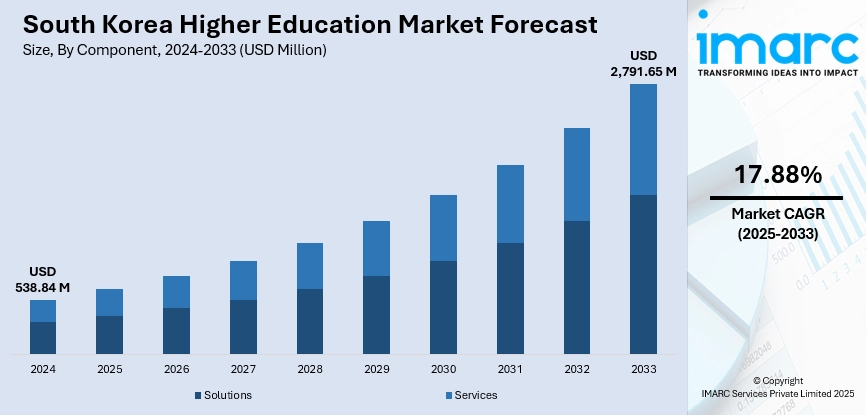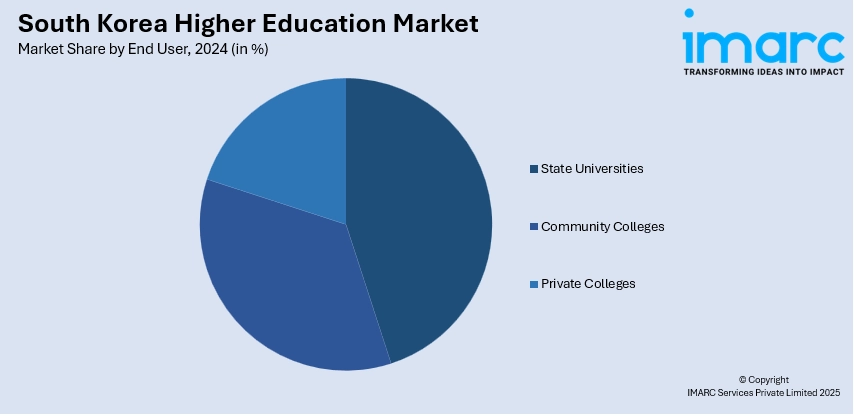
South Korea Higher Education Market Size, Share, Trends and Forecast by Component, Deployment Mode, Course Type, Learning Type, End User, and Region, 2025-2033
South Korea Higher Education Market Overview:
The South Korea higher education market size reached USD 538.84 Million in 2024. The market is projected to reach USD 2,791.65 Million by 2033, exhibiting a growth rate (CAGR) of 17.88% during 2025-2033. The market is driven by the rising demand for flexible, cost-effective online and hybrid programs, fueled by digital adoption and government-backed infrastructure investments. It is further propelled by the strategic push for internationalization, with policies such as "Study Korea 300K" and expanded English-taught programs attracting a growing influx of global students. Technological advancements and cross-border academic collaborations will continue enhancing competitiveness, further augmenting the South Korea higher education market share.
|
Report Attribute
|
Key Statistics
|
|---|---|
|
Base Year
|
2024
|
|
Forecast Years
|
2025-2033
|
|
Historical Years
|
2019-2024
|
| Market Size in 2024 | USD 538.84 Million |
| Market Forecast in 2033 | USD 2,791.65 Million |
| Market Growth Rate 2025-2033 | 17.88% |
South Korea Higher Education Market Trends:
Increasing Demand for Online and Hybrid Learning Programs
The market is experiencing a significant shift toward online and hybrid learning models. This trend has been accelerated by the COVID-19 pandemic, which forced universities to adopt digital platforms for remote education. South Korea's tertiary education sector is rapidly embracing remote learning, contributing substantially to a global e-learning market estimated to reach USD 457.8 Billion by 2026, with corporate e-learning expected to reach USD 50 Billion. Microlearning, which doubles retention rates to 90% and reduces development time by 60%, is being applied by South Korean schools and universities to respond to shifting student needs and improve global competitiveness through online education. One of the top countries investing over 50% in digital learning infrastructure, South Korea is poised to lead the expansion of online higher education in Asia through 2025. Even after the pandemic, students and institutions continue to favor flexible learning options due to their convenience and cost-effectiveness. Many universities, including prestigious ones such as Seoul National University and Korea University, now offer blended programs combining online lectures with in-person sessions. Additionally, the government is supporting this shift through policies promoting digital education infrastructure. The demand is also driven by working professionals seeking upskilling opportunities without disrupting their careers. Online MBA and certification programs are gaining popularity, with platforms such as Coursera and edX partnering with Korean universities. As technology advances, virtual reality (VR) and AI-powered learning tools are expected to further enhance online education, further propelling the South Korea higher education market growth.

To get more information on this market, Request Sample
Growing Focus on Internationalization and Global Partnerships
South Korean universities are increasingly prioritizing internationalization to attract global talent and improve competitiveness. Many institutions are expanding English-taught programs, dual-degree options, and exchange partnerships with foreign universities to draw more international students. For instance, the government’s "Study Korea 300K" scheme aims to attract 300,000 foreign students by 2027, having already surpassed 200,000 in 2023, as part of measures to address an estimated labor shortfall of 7.4 million by 2040. Supported by simplified visa procedures, the Global Korea Scholarship (GKS), and new career tracks in AI, quantum computing, and aerospace, this program facilitates greater cooperation among universities, companies, and regional authorities. This effort places South Korea's higher education sector as a center of global talent, which is crucial to its demographic sustainability and competitiveness of its high-tech sectors. Leading schools such as Yonsei University and KAIST have established global campuses and research collaborations with top-tier universities worldwide. Additionally, there is a rising emphasis on multicultural education to prepare students for global careers. Universities are incorporating intercultural training and language support services to enhance the experience of international students. This trend increases enrollment and enhances South Korea’s reputation as an education hub in Asia. As competition for global students intensifies, Korean institutions will continue to innovate in recruitment strategies and academic offerings to maintain their appeal.
South Korea Higher Education Market Segmentation:
IMARC Group provides an analysis of the key trends in each segment of the market, along with forecasts at the country and regional levels for 2025-2033. Our report has categorized the market based on component, deployment mode, course type, learning type, and end user.
Component Insights:
- Solutions
- Student Information Management System
- Content Collaboration
- Data Security and Compliance
- Campus Management
- Others
- Services
- Managed Services
- Professional Services
The report has provided a detailed breakup and analysis of the market based on the component. This includes solutions (student information management system, content collaboration, data security and compliance, campus management, and others), and services (managed services and professional services).
Deployment Mode Insights:
- On-premises
- Cloud-based
A detailed breakup and analysis of the market based on the deployment mode have also been provided in the report. This includes on-premises and cloud-based.
Course Type Insights:
- Arts
- Economics
- Engineering
- Law
- Science
- Others
The report has provided a detailed breakup and analysis of the market based on the course type. This includes arts, economics, engineering, law, science, and others.
Learning Type Insights:
- Online
- Offline
A detailed breakup and analysis of the market based on the learning type have also been provided in the report. This includes online and offline.
End User Insights:

- State Universities
- Community Colleges
- Private Colleges
The report has provided a detailed breakup and analysis of the market based on the end user. This includes state universities, community colleges, and private colleges.
Regional Insights:
- Seoul Capital Area
- Yeongnam (Southeastern Region)
- Honam (Southwestern Region)
- Hoseo (Central Region)
- Others
The report has also provided a comprehensive analysis of all the major regional markets, which include Seoul Capital Area, Yeongnam (Southeastern Region), Honam (Southwestern Region), Hoseo (Central Region), and others.
Competitive Landscape:
The market research report has also provided a comprehensive analysis of the competitive landscape. Competitive analysis such as market structure, key player positioning, top winning strategies, competitive dashboard, and company evaluation quadrant has been covered in the report. Also, detailed profiles of all major companies have been provided.
South Korea Higher Education Market Report Coverage:
| Report Features | Details |
|---|---|
| Base Year of the Analysis | 2024 |
| Historical Period | 2019-2024 |
| Forecast Period | 2025-2033 |
| Units | Million USD |
| Scope of the Report |
Exploration of Historical Trends and Market Outlook, Industry Catalysts and Challenges, Segment-Wise Historical and Future Market Assessment:
|
| Components Covered |
|
| Deployment Modes Covered | On-premises, Cloud-based |
| Course Types Covered | Arts, Economics, Engineering, Law, Science, Others |
| Learning Types Covered | Online, Offline |
| End Users Covered | State Universities, Community Colleges, Private Colleges |
| Regions Covered | Seoul Capital Area, Yeongnam (Southeastern Region), Honam (Southwestern Region), Hoseo (Central Region), Others |
| Customization Scope | 10% Free Customization |
| Post-Sale Analyst Support | 10-12 Weeks |
| Delivery Format | PDF and Excel through Email (We can also provide the editable version of the report in PPT/Word format on special request) |
Key Questions Answered in This Report:
- How has the South Korea higher education market performed so far and how will it perform in the coming years?
- What is the breakup of the South Korea higher education market on the basis of component?
- What is the breakup of the South Korea higher education market on the basis of deployment mode?
- What is the breakup of the South Korea higher education market on the basis of course type?
- What is the breakup of the South Korea higher education market on the basis of learning type?
- What is the breakup of the South Korea higher education market on the basis of end user?
- What is the breakup of the South Korea higher education market on the basis of region?
- What are the various stages in the value chain of the South Korea higher education market?
- What are the key driving factors and challenges in the South Korea higher education market?
- What is the structure of the South Korea higher education market and who are the key players?
- What is the degree of competition in the South Korea higher education market?
Key Benefits for Stakeholders:
- IMARC’s industry report offers a comprehensive quantitative analysis of various market segments, historical and current market trends, market forecasts, and dynamics of the South Korea higher education market from 2019-2033.
- The research report provides the latest information on the market drivers, challenges, and opportunities in the South Korea higher education market.
- Porter's five forces analysis assist stakeholders in assessing the impact of new entrants, competitive rivalry, supplier power, buyer power, and the threat of substitution. It helps stakeholders to analyze the level of competition within the South Korea higher education industry and its attractiveness.
- Competitive landscape allows stakeholders to understand their competitive environment and provides an insight into the current positions of key players in the market.
Need more help?
- Speak to our experienced analysts for insights on the current market scenarios.
- Include additional segments and countries to customize the report as per your requirement.
- Gain an unparalleled competitive advantage in your domain by understanding how to utilize the report and positively impacting your operations and revenue.
- For further assistance, please connect with our analysts.
 Request Customization
Request Customization
 Speak to an Analyst
Speak to an Analyst
 Request Brochure
Request Brochure
 Inquire Before Buying
Inquire Before Buying




.webp)




.webp)












